engine CITROEN C4 2018 Workshop Manual
[x] Cancel search | Manufacturer: CITROEN, Model Year: 2018, Model line: C4, Model: CITROEN C4 2018Pages: 317, PDF Size: 9.31 MB
Page 151 of 317

149
C4-cactus_en_Chap06_conduite_ed01-2016
In bad weather and in winter, ensure
that the sensors are not covered by
roadô dirt, ô ice ô or ô snow.
In
ô the ô event ô of ô a ô fault, ô have ô the ô system ô
c
hecked ô by ô a ô CITROûN ô dealer ô or ô a ô
q
ualified
ô w
orkshop.
If
ô
the
ô
system
ô
is
ô
deactivated
ô
during
ô
a
ô
m
anoeuvre,
ô
the
ô
driver
ô
should
ô
reactivate
ô
i
t
ô
to
ô
repeat
ô
the
ô
measurement.
If the lateral distance between your vehicle
andô the ô space ô is ô too ô great, ô the ô system ô may
ô n
ot ô be ô able ô to ô measure ô the ô space.
Anything ô projecting ô beyond ô the ô envelope
ô o
f ô the ô vehicle ô (long ô or ô wide ô load) ô is ô not
ô t
aken ô into ô account ô by ô the ô Park ô Assist
ô s
ystem ô during ô a ô manoeuvre.
Deactivation
Aô messageô isô displayedô inô theô screen.
T he ô driver ô then ô takes ô back ô control ô of ô the ô
v
ehicle's
ô s
teering.
The
ô
system
ô
is
ô
deactivated
ô
by
ô
pressing
ô
the
ô P
ark
ô
Assist
ô
control
ô
(or
ô
the
ô
Park
ô
Assist
ô
button
ô
i
n the " Driving assistance "
ô
menu
ô
of
ô
the
ô
touch
ô
s
creen tablet),
The
ô
system
ô
is
ô
deactivated
ô
automatically:
-
ô
o
n
ô
switching
ô
off
ô
the
ô
ignition,
-
ô
i
f
ô
the
ô
engine
ô
stalls,
-
ô
i
f
ô
no
ô
manoeuvre
ô
is
ô
started
ô
within
ô
5
ô
minutes
ô
o
f
ô
selection
ô
of
ô
the
ô
type
ô
of
ô
manoeuvre,
-
ô
a
fter
ô
a
ô
prolonged
ô
stop
ô
of
ô
the
ô
vehicle
ô
during
ô
a
ô
manoeuvre,
-
ô
i
f
ô
the
ô
road
ô
wheel
ô
anti-spin
ô
regulation
ô
(ASR)
ô
s
ystem
ô
is
ô
invoked,
-
ô
i
f
ô
the
ô
speed
ô
of
ô
the
ô
vehicle
ô
exceeds
ô
the
ô
s
tated
ô
limit,
-
ô
w
hen
ô
the
ô
driver
ô
interrupts
ô
movement
ô
of
ô
the
ô
s
teering
ô w
heel,
-
ô
i
f
ô
the
ô
driver
ô
presses
ô
the
ô
Park
ô
Assist
ô
control
ô
(
or
ô
the
ô
Park
ô
Assist
ô
button
ô
of
ô
the
ô
"Driving
ô
a
ssistance"
ô
menu
ô
in
ô
the
ô
touch
ô
screen
ô
t
ablet),
-
ô
i
f
ô
correct
ô
positioning
ô
of
ô
the
ô
vehicle
ô
is
ô
not
ô
p
ossible
ô
(too
ô
many
ô
manoeuvres
ô
needed
ô
to
ô
i
nsert
ô
or
ô
extract
ô
the
ô
vehicle),
-
ô
i
f
ô
the
ô
driver's
ô
door
ô
is
ô
open,
-
i
f one of the front wheels encounters an
obstacle.
Switching off
Theô systemô isô switchedô offô automatically:
- ô w hen ô towing ô a ô trailer,
-
ô
i
f ô the ô driver's ô door ô is ô opened,
-
ô
i
f ô the ô speed ô of ô the ô vehicle ô is ô above ô 42 ô mph ô
(
70 ô km/h).
To
ô switch ô the ô system ô of ô for ô a ô prolonged ô period, ô
c
ontact ô a ô CITROûN ô dealer ô or ô a ô qualified ô
w
orkshop.
Operating faults
Inô theô eventô ofô aô faultô withô theô system,ô the ô symbol ô in ô the ô button ô (located ô in ô
t
he ô touch ô screen ô tablet) ô changes ô to ô
a
lert ô mode ô and ô the ô warning ô lamp ô
f
lashes ô and ô then ô goes ô off.
Contact
ô
a
ô CITROûN ô dealer ô or ô a ô qualified ô
w
orkshop.
6
Driving
Page 155 of 317

153
C4-cactus_en_Chap07_info-pratiques_ed01-2016
Fuelô tank
Capacity of the tank:
-ô Pe trol: ô approximately ô 50 ô litres.
-
ô
D
iesel: ô approximately ô 45 ô or ô 50 ô litres ô (depending ô on ô version).
Low fuel levelRefuelling
When the low fuel level is reached,
this
ô warning ô lamp ô in ô the ô instrument ô
p
anel ô comes ô on, ô accompanied ô by ô
a
n ô audible ô warning, ô a ô message ô and ô
t
he ô last ô bar ô of ô the ô fuel ô gauge ô flashes ô
i
n ô red.
To
ô refuel ô in ô complete ô safety:
F
Y
ou must switch off the engine.
F
ô
O
pen ô the ô filler ô flap.
A label on the inside of the fuel filler flap
reminds
ô you ô of ô the ô type ô of ô fuel ô to ô use, ô
d
epending ô on ô your ô engine ô type.
Additions
ô of ô fuel ô must ô be ô of ô at ô least ô 5 ô litres ô to ô
b
e ô registered ô by ô the ô fuel ô gauge.
When
ô
it
ô
first ô comes ô on, ô about 5 litres of fuel
remain
ô
in
ô
the ô tank.
Until sufficient fuel has been added, this
warning
ô
lamp ô appears ô every ô time ô the ô ignition ô
i
s
ô
switched ô on, ô accompanied ô by ô an ô audible ô
w
arning
ô
and ô a ô message. ô This ô audible ô warning ô
a
nd
ô
message ô are ô repeated ô with ô increasing ô
f
requency
ô as ô the ô fuel ô level ô drops ô towards ô "0 ".
Refuel
ô
as
ô soon ô as ô possible ô to ô avoid ô running ô
o
ut. Opening
ô the ô filler ô cap ô may ô result ô in ô an ô inrush ô of ô
a
ir. ô This ô is ô entirely ô normal ô and ô results ô from ô the ô
s
ealing ô of ô the ô fuel ô system.
With Stop & Start, never refuel with the
system
ô in ô STOP ô mode; ô you ô must ô switch ô
o
ff ô the ô ignition ô with ô the ô key.
For
ô more ô information ô on ô running ô out ô of ô
f
uel ô (Diesel), ô refer ô to ô the ô corresponding ô
s
ection. F
ô
T
ake ô care ô to ô select ô the ô pump ô that ô delivers ô
t
he ô correct ô type ô of ô fuel ô for ô your ô vehicle.
F
ô
I
ntroduce ô the ô key ô into ô the ô cap ô and ô turn ô it ô to ô
t
he ô left.
7
Practical information
Page 156 of 317

154
C4-cactus_en_Chap07_info-pratiques_ed01-2016
Fô Removeô the ô cap ô and ô place ô it ô on ô its ô support ô (
on ô the ô filler ô flap).
F
I
ntroduce the filler nozzle and push it in as
far
ô as ô possible ô before ô starting ô to ô refuel ô
(risk
ô of ô blowback).
F
ô
M
aintain ô this ô position ô throughout ô the ô
r
efuelling
ô ope
ration.
Once
ô you ô have ô finished ô refuelling:
F
ô
R
efit ô the ô filler ô cap.
F
ô
T
urn ô the ô key ô to ô the ô right, ô then ô remove ô it ô
f
rom ô the ô cap.
F
ô
P
ush ô the ô fuel ô flap ô to ô close ô it.If you are filling your tank to the top, do
not persist after the 3rd cut- off; this could
cause malfunctions.
The
ô petrol ô or ô Diesel ô engine ô of ô your ô vehicle ô is ô
f
itted with a catalytic converter, a device which
helps ô to ô reduce ô the ô level ô of ô harmful ô emissions ô
i
n ô the ô exhaust ô gases.
For petrol engines, you must use unleaded
fuel.
The ô filler ô neck ô is ô narrower, ô allowing ô only ô
u
nleaded ô petrol ô nozzles ô to ô be ô introduced.
Your ô vehicle ô is ô equipped ô with ô a ô safety ô device ô
w
hich cuts off the fuel supply in the event of a
collision.
Fuel cut- of f
If you have put in the wrong fuel
for your vehicle, you must have the
fuel tank drained and filled with
the correct fuel before star ting the
engine.
Practical information
Page 158 of 317

156
C4-cactus_en_Chap07_info-pratiques_ed01-2016
Fuel used for petrol
engines
Theô petrolô enginesô areô compatibleô withô E
10ô type ô petrol ô biofuels ô (containing ô 10 ô % ô
e
thanol), ô conforming ô to ô European ô standards ô
E
N ô 228 ô and ô EN ô 15376.
E85
ô type ô fuels ô (containing ô up ô to ô 85 ô % ô ethanol) ô
a
re ô reserved ô exclusively ô for ô vehicles ô marketed ô
f
or ô the ô use ô of ô this ô type ô of ô fuel ô (BioFlex ô
v
ehicles). ô The ô quality ô of ô the ô ethanol ô must ô
c
omply ô with ô European ô standard ô EN ô 15293.
Fuel used for Diesel
engines
Theô Dieselô enginesô areô compatibleô withô biofuels ô available ô at ô the ô pumps ô which ô meet ô
c
urrent ô and ô future ô European ô standards:
-
ô
D
iesel ô fuel ô that ô meets ô standard ô EN ô 590 ô
m
ixed ô with ô a ô biofuel ô that ô meets ô standard ô
E
N 14214,
-
ô
D
iesel ô fuel ô that ô meets ô standard ô EN16734 ô
m
ixed ô with ô a ô biofuel ô that ô meets ô standard ô
E
N14214 ô (possibly ô containing ô up ô to ô 10 ô % ô
F
atty Acid Methyl Ester),
-
ô
P
araffinic ô Diesel ô fuel ô that ô meets ô standard ô
E
N15940 ô mixed ô with ô a ô biofuel ô that ô meets ô
s
tandard ô EN14214 ô (possibly ô containing ô up ô
t
o ô 7 ô % ô Fatty ô Acid ô Methyl ô Ester).The
ô use ô of ô B20 ô or ô B30 ô fuel ô meeting ô standard ô E
N16709 ô is ô possible ô in ô your ô Diesel ô engines. ô
H
owever, ô this ô use, ô even ô occasional, ô requires ô
s
trict ô application ô of ô the ô special ô servicing ô
c
onditions ô referred ô to ô as ô "Arduous ô conditions". ô
F
or ô more ô information, ô contact ô a ô CITROûN ô
d
ealer ô or ô a ô qualified ô workshop.
The use of any other type of (bio)fuel
(vegetable
ô or ô animal ô oils, ô pure ô or ô diluted, ô
d
omestic ô fuel...) ô is ô strictly ô prohibited ô (risk ô of ô
d
amage ô to ô the ô engine ô and ô fuel ô system).
Only
ô the ô use ô of ô Diesel ô fuel ô additives ô that ô meet ô
t
he ô standard ô B715000 ô is ô authorised.
Practical information
Page 160 of 317

158
C4-cactus_en_Chap07_info-pratiques_ed01-2016
Veryô coldô climateô screens
Removableô protectiveô screensô whichô preventsô theô accumulationô ofô snowô atô theô radiatorô
c ooling ô fan.
F
ô
O
ffer ô up ô the ô corresponding ô screen ô to ô the ô
f
ront ô bumper ô upper ô grille.
F
ô
P
ress ô on ô the ô edge ô to ô engage ô its ô fixing ô clips ô
i
n ô turn.
Proceed
ô in ô the ô same ô way ô for ô the ô screen ô on ô the ô
l
ower ô grille. F
ô
U
sing ô a ô screwdriver, ô lever ô in ô turn ô on ô the ô
f
ixings ô of ô each ô screen ô to ô unclip ô them.
Do
ô not ô forget ô to ô remove ô the ô very ô cold
ô c
limate ô screens ô when:
-
ô t
he ô ambient ô temperature ô exceeds
ô 1
0ô¯ ô C,
-
ô tow
ing,
-
ô a
t ô speeds ô above ô 75 ô mph ô (120 ô km/h).
Removal
Fitting
Beforeô fittingô orô removingô aô screen,ô e
nsure ô that ô the ô engine ô is ô off ô and ô the ô
c
ooling ô fan ô has ô stopped. It
ô is ô recommended ô that ô the ô screens ô b
e ô fitted ô and ô removed ô by ô a ô CITROûN ô
d
ealer ô or ô a ô qualified ô workshop.
Practical information
Page 162 of 317
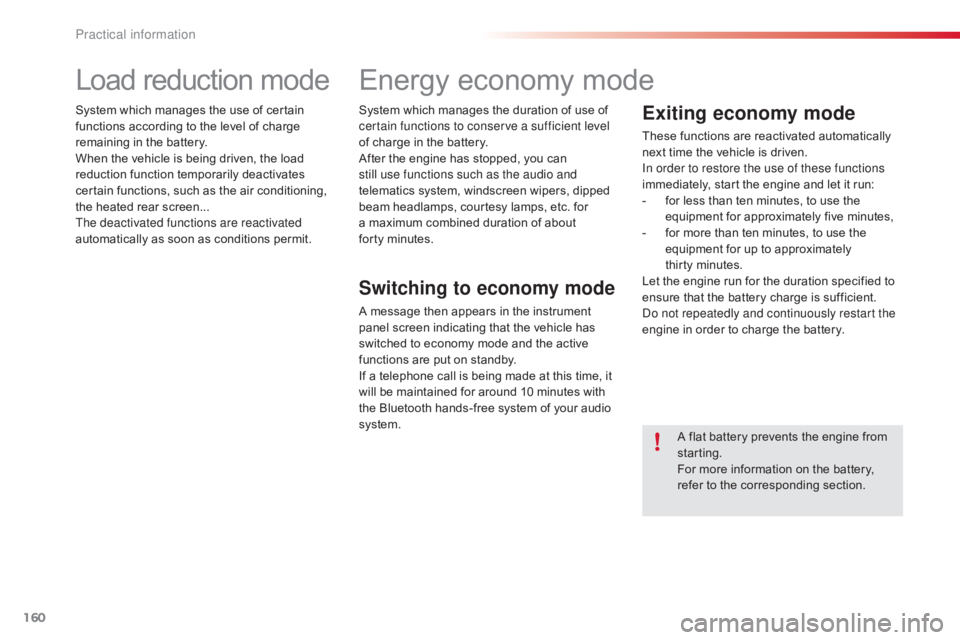
160
C4-cactus_en_Chap07_info-pratiques_ed01-2016
Loadô reductionô mode
Systemô whichô managesô theô useô ofô certainô functions ô according ô to ô the ô level ô of ô charge ô
r
emaining ô in ô the ô battery.
When
ô the ô vehicle ô is ô being ô driven, ô the ô load ô
r
eduction ô function ô temporarily ô deactivates ô
c
ertain ô functions, ô such ô as ô the ô air ô conditioning, ô
t
he ô heated ô rear ô screen...
The deactivated functions are reactivated
automatically
ô as ô soon ô as ô conditions ô permit.System
ô which ô manages ô the ô duration ô of ô use ô of ô c
ertain functions to conserve a sufficient level
of
ô charge ô in ô the ô battery.
After
ô the ô engine ô has ô stopped, ô you ô can ô
s
till use functions such as the audio and
telematics
ô system,ô windscreen ô wipers, ô dipped ô
b
eam ô headlamps,ô courtesy ô lamps, ô etc. ô for ô
a
ô maximum ô combined ô duration ô of ô about ô
f
ortyô minutes.
Energyô economyô mode
Switching to economy mode
Aô messageô thenô appearsô inô theô instrumentô p
anel ô screen ô indicating ô that ô the ô vehicle ô has ô
s
witched ô to ô economy ô mode ô and ô the ô active ô
f
unctions ô are ô put ô on ô standby.
If
ô a ô telephone ô call ô is ô being ô made ô at ô this ô time, ô it ô
w
ill ô be ô maintained ô for ô around ô 10 ô minutes ô with ô
t
he ô Bluetooth ô hands-free ô system ô of ô your ô audio ô
s
ystem.
Exiting economy mode
Theseô functionsô areô reactivatedô automaticallyô n ext ô time ô the ô vehicle ô is ô driven.
In order to restore the use of these functions
immediately,
ô start ô the ô engine ô and ô let ô it ô run:
-
ô
f
or ô less ô than ô ten ô minutes, ô to ô use ô the ô
e
quipment ô for ô approximately ô five ô minutes,
-
ô
f
or ô more ô than ô ten ô minutes, ô to ô use ô the ô
e
quipment ô for ô up ô to ô approximately ô
t
hirtyô minutes.
Let
ô the ô engine ô run ô for ô the ô duration ô specified ô to ô
e
nsure ô that ô the ô battery ô charge ô is ô sufficient.
Do not repeatedly and continuously restart the
engine
ô in ô order ô to ô charge ô the ô battery.
A
ô flat ô battery ô prevents ô the ô engine ô from ô
s
tarting.
For
ô more ô information ô on ô the ô battery, ô
r
efer ô to ô the ô corresponding ô section.
Practical information
Page 168 of 317
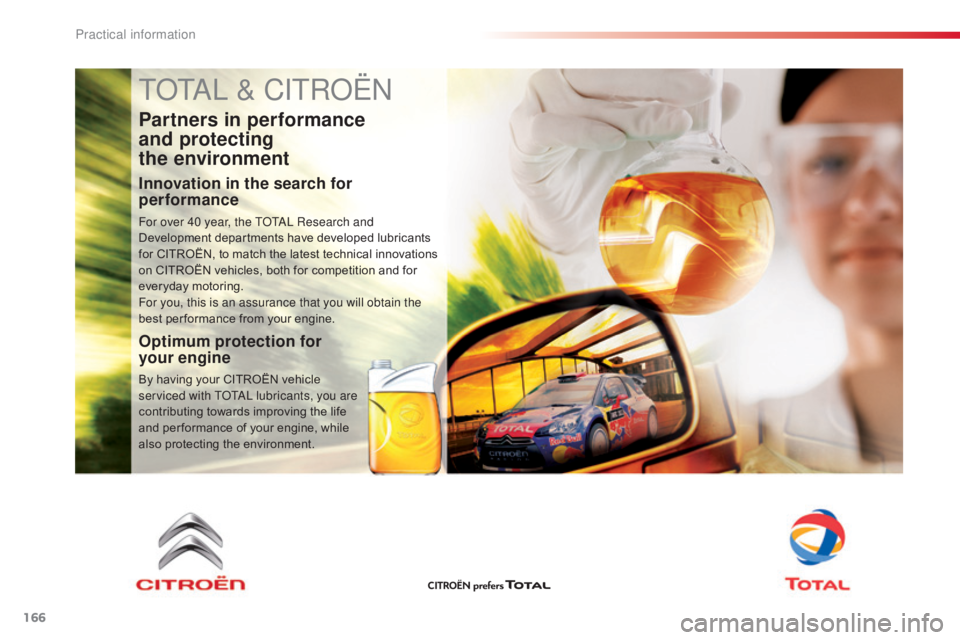
166
C4-cactus_en_Chap07_info-pratiques_ed01-2016
TOTAL & CITROûN
Partners in performance
and protecting
the environment
Innovation in the search for
performance
For over 40 year, the TOTAL Research and
Development
ô departments ô have ô developed ô lubricants ô
f
or ô CITROûN, ô to ô match ô the ô latest ô technical ô innovations ô
o
n ô CITROûN ô vehicles, ô both ô for ô competition ô and ô for ô
e
veryday ô motoring.
For you, this is an assurance that you will obtain the
best
ô per formance ô from ô your ô engine.
Optimum protection for
your engine
Byô havingô yourô CITROûNô vehicleô serviced with TOTAL lubricants, you are
contributing
ô towards ô improving ô the ô life ô
a
nd ô per formance ô of ô your ô engine, ô while ô
a
lso ô protecting ô the ô environment.
Practical information
Page 169 of 317
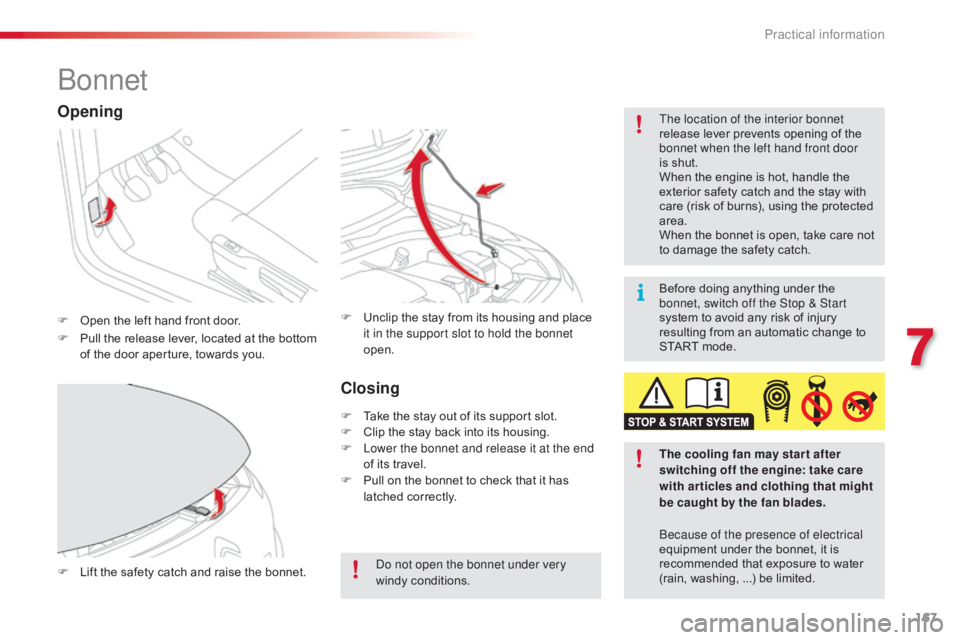
167
C4-cactus_en_Chap07_info-pratiques_ed01-2016
Bonnet
Fô Openô the ô left ô hand ô front ô door. The location of the interior bonnet
release
ô lever ô prevents ô opening ô of ô the ô
b
onnet when the left hand front door
is ô shut.
When ô the ô engine ô is ô hot, ô handle ô the ô
e
xterior ô safety ô catch ô and ô the ô stay ô with ô
c
are ô (risk ô of ô burns), ô using ô the ô protected ô
a
rea.
When ô the ô bonnet ô is ô open, ô take ô care ô not ô
t
o ô damage ô the ô safety ô catch.
F ô
L
ift ô the ô safety ô catch ô and ô raise ô the ô bonnet.F
ô U nclip ô the ô stay ô from ô its ô housing ô and ô place ô i
t in the support slot to hold the bonnet
open.
Opening
Fô Pull ô the ô release ô lever, ô located ô at ô the ô bottom ô o
f ô the ô door ô aperture, ô towards ô you.
The cooling fan may star t after
switching off the engine: take care
with articles and clothing that might
be caught by the fan blades.
Do not open the bonnet under very
windy
ô c
onditions.
Closing
Fô Takeô the ô stay ô out ô of ô its ô support ô slot.
F ô C lip ô the ô stay ô back ô into ô its ô housing.
F
L
ower the bonnet and release it at the end
of
ô its ô travel.
F
ô
P
ull ô on ô the ô bonnet ô to ô check ô that ô it ô has ô
l
atched ô correctly. Because of the presence of electrical
equipment
ô under ô the ô bonnet, ô it ô is ô
r
ecommended ô that ô exposure ô to ô water ô
(
rain, ô washing,ô ...) ô be ô limited.
Before
ô doing ô anything ô under ô the ô
b
onnet, switch off the Stop & Start
system ô to ô avoid ô any ô risk ô of ô injury ô
r
esulting ô from ô an ô automatic ô change ô to ô
S
TART ô mode.
7
Practical information
Page 170 of 317
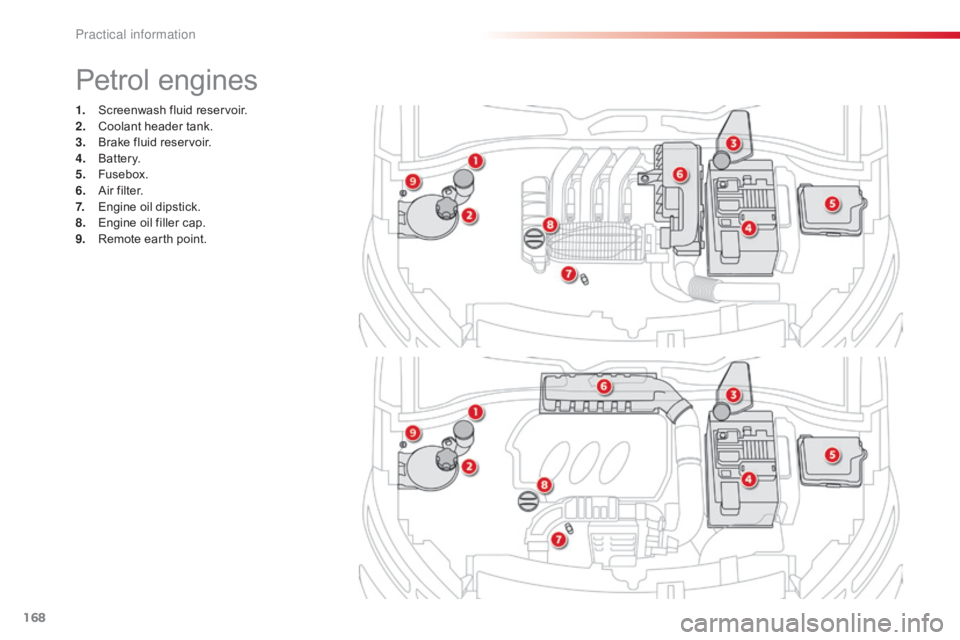
168
C4-cactus_en_Chap07_info-pratiques_ed01-2016
1.ô Screenwashô fluid ô reservoir.
2.ô C oolant ô header ô tank.
3.
ô B
rake ô fluid ô reservoir.
4.
ô B
attery.
5.
ô F
usebox.
6.
ô A
ir ô filter.
7.
ô E
ngine ô oil ô dipstick.
8.
ô E
ngine ô oil ô filler ô cap.
9.
ô R
emote ô earth ô point.
Petrolô engines
Practical information
Page 171 of 317
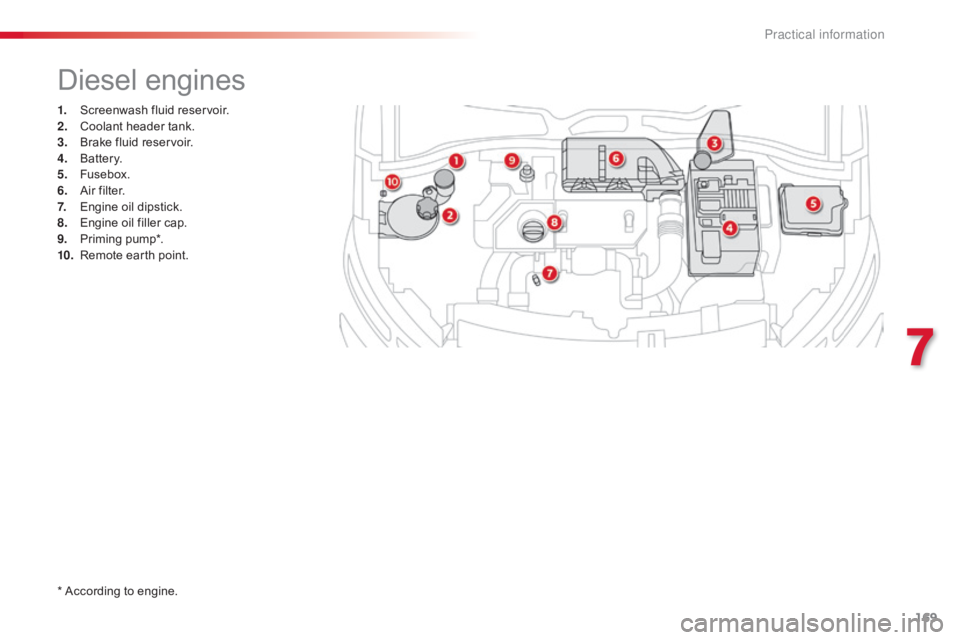
169
C4-cactus_en_Chap07_info-pratiques_ed01-2016
1.ô Screenwashô fluid ô reservoir.
2.ô C oolant ô header ô tank.
3.
ô B
rake ô fluid ô reservoir.
4.
ô B
attery.
5.
ô F
usebox.
6.
ô A
ir ô filter.
7.
ô E
ngine ô oil ô dipstick.
8.
ô E
ngine ô oil ô filler ô cap.
9.
ô P
riming
ô pu
mp*.
10.
ô R
emote ô earth ô point.
Dieselô engines
*ô Accordingô toô engine.
7
Practical information